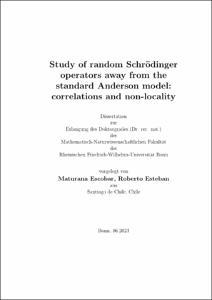Maturana Escobar, Roberto Esteban: Study of random Schrödinger operators away from the standard Anderson model: correlations and non-locality. - Bonn, 2023. - Dissertation, Rheinische Friedrich-Wilhelms-Universität Bonn.
Online-Ausgabe in bonndoc: https://nbn-resolving.org/urn:nbn:de:hbz:5-72967
Online-Ausgabe in bonndoc: https://nbn-resolving.org/urn:nbn:de:hbz:5-72967
@phdthesis{handle:20.500.11811/11118,
urn: https://nbn-resolving.org/urn:nbn:de:hbz:5-72967,
author = {{Roberto Esteban Maturana Escobar}},
title = {Study of random Schrödinger operators away from the standard Anderson model: correlations and non-locality},
school = {Rheinische Friedrich-Wilhelms-Universität Bonn},
year = 2023,
month = oct,
note = {This thesis focuses on the investigation of two distinct variations of the Anderson model, where we relax the standard assumptions. In the first half of our study, we investigate a version of the Anderson model on the one-dimensional lattice strip or ladder of width 2, denoted as $Gamma=D_{2}:=mathbb{Z}times{0,1}{F_DISS_ABSTRACT} with $d=1$, wherein the free operator is the graph Laplacian and the random variables $omega=(omega_{x})_{xin D_{2}}$ are identically distributed but not always independent. We adapt the supersymmetric approach presented by Klein, Martinelli and Perez in 1986 from the uni-dimensional lattice $mathbb{Z}$ to $D_{2}$, which is not one-dimensional. This adaptation allows us to obtain a representation of the square modulus of the 4-points average of the Green’s functions corresponding to two layers of $D_{2}$. Although we succeeded in expressing this squared average in terms of transfer operators, the analytic estimate poses technical challenges which we have not been able to overcome. Hence, we are still unable to show localization in our specific context. Nonetheless, our extension of Klein, Martinelli and Perez’s approach is interesting on its own and could serve as a starting point for future investigations.
In the second half of our study, we examine a specific instance of the Anderson model on $Gamma=mathbb{Z}^{d}$ with $dinmathbb{N}$ known as the fractional Anderson model. In this model the random variables $omega=(omega_{x})_{xinmathbb{Z}^{d}}$ are iid and the free operator is the fractional Laplacian, which is not a local operator and exhibits a slow rate in the decay of its matrix elements. Adapting Schenker’s arguments in 2015, we relate the fractional moments of the Green’s function to the two-point correlation function of a self-avoiding walk with polynomial long-range jumps. This together with the use of known probabilistic techniques yield sharper bounds for the fractional moments of the Green’s function at strong disorder, surpassing the previous bounds in the literature. Notably, we expand the range of the disorder parameter $lambda$ where spectral localization happens. Furthermore, for $d=1$, we prove polynomial decay of the eigenfunctions almost-surely, assuming some regularity of the probability distribution of $omega_x$ with $xinmathbb{Z}$.},
url = {https://hdl.handle.net/20.500.11811/11118}
}
urn: https://nbn-resolving.org/urn:nbn:de:hbz:5-72967,
author = {{Roberto Esteban Maturana Escobar}},
title = {Study of random Schrödinger operators away from the standard Anderson model: correlations and non-locality},
school = {Rheinische Friedrich-Wilhelms-Universität Bonn},
year = 2023,
month = oct,
note = {This thesis focuses on the investigation of two distinct variations of the Anderson model, where we relax the standard assumptions. In the first half of our study, we investigate a version of the Anderson model on the one-dimensional lattice strip or ladder of width 2, denoted as $Gamma=D_{2}:=mathbb{Z}times{0,1}{F_DISS_ABSTRACT} with $d=1$, wherein the free operator is the graph Laplacian and the random variables $omega=(omega_{x})_{xin D_{2}}$ are identically distributed but not always independent. We adapt the supersymmetric approach presented by Klein, Martinelli and Perez in 1986 from the uni-dimensional lattice $mathbb{Z}$ to $D_{2}$, which is not one-dimensional. This adaptation allows us to obtain a representation of the square modulus of the 4-points average of the Green’s functions corresponding to two layers of $D_{2}$. Although we succeeded in expressing this squared average in terms of transfer operators, the analytic estimate poses technical challenges which we have not been able to overcome. Hence, we are still unable to show localization in our specific context. Nonetheless, our extension of Klein, Martinelli and Perez’s approach is interesting on its own and could serve as a starting point for future investigations.
In the second half of our study, we examine a specific instance of the Anderson model on $Gamma=mathbb{Z}^{d}$ with $dinmathbb{N}$ known as the fractional Anderson model. In this model the random variables $omega=(omega_{x})_{xinmathbb{Z}^{d}}$ are iid and the free operator is the fractional Laplacian, which is not a local operator and exhibits a slow rate in the decay of its matrix elements. Adapting Schenker’s arguments in 2015, we relate the fractional moments of the Green’s function to the two-point correlation function of a self-avoiding walk with polynomial long-range jumps. This together with the use of known probabilistic techniques yield sharper bounds for the fractional moments of the Green’s function at strong disorder, surpassing the previous bounds in the literature. Notably, we expand the range of the disorder parameter $lambda$ where spectral localization happens. Furthermore, for $d=1$, we prove polynomial decay of the eigenfunctions almost-surely, assuming some regularity of the probability distribution of $omega_x$ with $xinmathbb{Z}$.},
url = {https://hdl.handle.net/20.500.11811/11118}
}






